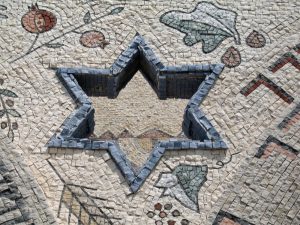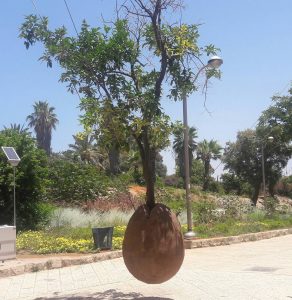The Beginning of the Israeli Art
The birth of the visual art dates back to the 20th century when the “Bezalel School of Arts and Crafts,” known as “Bezalel”, has been established in the 1906 by Professor Boris Schatz, who arrived from Bulgaria. In the 1910, the school were structured in 32 departments and counted 500 students, among them, there were painters, sculptors, ceramicists, silver and goldsmiths, weavers, calligraphers and glass blowers. Different influences from European cultures came to Israel in a fusion of many techniques forming the Israeli Art whose main artists were Shmuel Hirszenberg, Ephraim Lilien, and Abel Pann.

The Bezalel School
In the 1921 the fist art exhibition in the Jerusalem’s Old City was leaded by Bezalel school’s artists, that started to give an Israeli imprint that they named “Hebrew”, using characteristic bright light and glowing colors reflecting the exotic beauty of the Israeli landscape sometimes describing the Arab lifestyle, in this current the artists Israel Paldi, Tziona Tagger, Pinhas Litvinovsky, Nahum Gutman, and Reuven Rubin are the main protagonists of this artistic trend. Starting from the 1909 the capital of the artistic life was Tel Aviv. Since 1930s the Israeli art is subjected to the strong influence of the European culture, mostly from Paris, as it’s possible to notice in the artworks of Moshe Castel, Menachem Shemi, and Arie Aroch where the reality is mystically distorted even though Israeli landscapes are images appear but without anymore the narrative element. Afterwards due to the arrival of German immigrants, because of the rising Nazism, the German expressionism is introduced in the Israeli art, that with artists like Anna Ticho, Leopold Krakauer, Hermann Struck, Mordechai Ardon, and Jakob Steinhardt, had an evolution in particular with Ardon and Steinhardt, whose artworks are often reproducing the Jerusalem’s landscapes and the surrounding hills.
The Canaanite Art
During the second world war and the tragedy of the Holocaust, some artists like Moshe Castel, Yitzhak Danziger, and Aharon Kahana initiated the “Canaanite” subject in their paintings creating “new Hebrew people” with ancient myths and pagan subjects. Around 1948 a new artistic group arose with the name “New Horizons” that was influenced by contemporary European art, inside this current Yosef Zaritzky, the main painter of this current, was using local landscapes and cool color tones. Zaritzky’s style was adopted by Avigdor Stematsky and Yehezkel Streichman. Another artist, Marcel Janco, from Romania, studied in Paris and was one of the founders of the Dadaism. The “New Horizons” current dominated in the Israeli art until the 1960, and Streitchman with Stematsky, who were teaching at the Avni Institute in Tel Aviv, were the leaders of a group of artists like Raffi Lavi, Aviva Uri, Uri Lifschitz, and Lea Nikel who used mixed abstractionism with various styles taken from abroad.
The Group of Ten
In the late 1950s “The Group of Ten” drove towards an art that was more focused on Israeli landscapes and local people, and they were identified with the native Israeli “Sabra” and the Palmah generation, afterwards Ori Reisman and Yitzhak Mambush were part of “The Group of Ten”. The figurative themes in this period are the Holocaust and traditional Jewish subjects as it can be seen in the surrealistic paintings of Yossl Bergner and Samuel Bak. With Jacob Agam there is the arise of a new style, that is the optic and kinetic art. In the 1980s and 1990s, the subjects of the visual art are the local elements like the Hebrew alphabet and the human emotions. In the paintings of Pinhas Cohen-Gan, Deganit Beresht, Gabi Klasmer, Tsibi Geva, Tzvi Goldstein, David Reeb and others, there is the unique expression of the Israeli culture and the component of the Western art mixed together.
In the sculpture the main artists were Avraham Malnikoff, known for the stone lion in Tel Hai, Ze’ev Ben-Zvi, who introduced the cubism, Moshe Ziffer, Aharon Priver and Batya Lishansky. At the end of 1940s, the “Canaanite” ideology influenced a lot of artists, such as Yitzhak Danziger, who combined the Middle Eastern sculpture with the modern concept of the human body, like in his sculptures of sheeps, as it is in the Bedouin’s desert ambience.

The 50th and 60th
In the 1950s new materials are employed and the style become more abstract, mainly due to the introduction of the iron and Cor-Ten steel as principle material of the sculpture. In the 1960s there was the production of many big monuments like the steel naval memorial of Yehiel Shemi at Achziv, where the harshness of the nature is combined with the human violence and destruction, and like the Dani Karavan’s “Monument to the Negev Brigade” outside Beersheba.
Contemporary artists
Contemporary artists creates installations and sculptures that reflect their point of view about politics and society, an example is the artworks of Yigal Tumarkin, where his protest against war is expressed by means of geometric and figurative abstracts forms, meanwhile in Menashe Kadishman’s artworks the images of sheeps recalls the biblical sacrifice of Isaac and the silent sacrifice of innocents. Other artists of this period are Tumarkin, Karavan, Kosso Eloul, and Israel Hadany.


